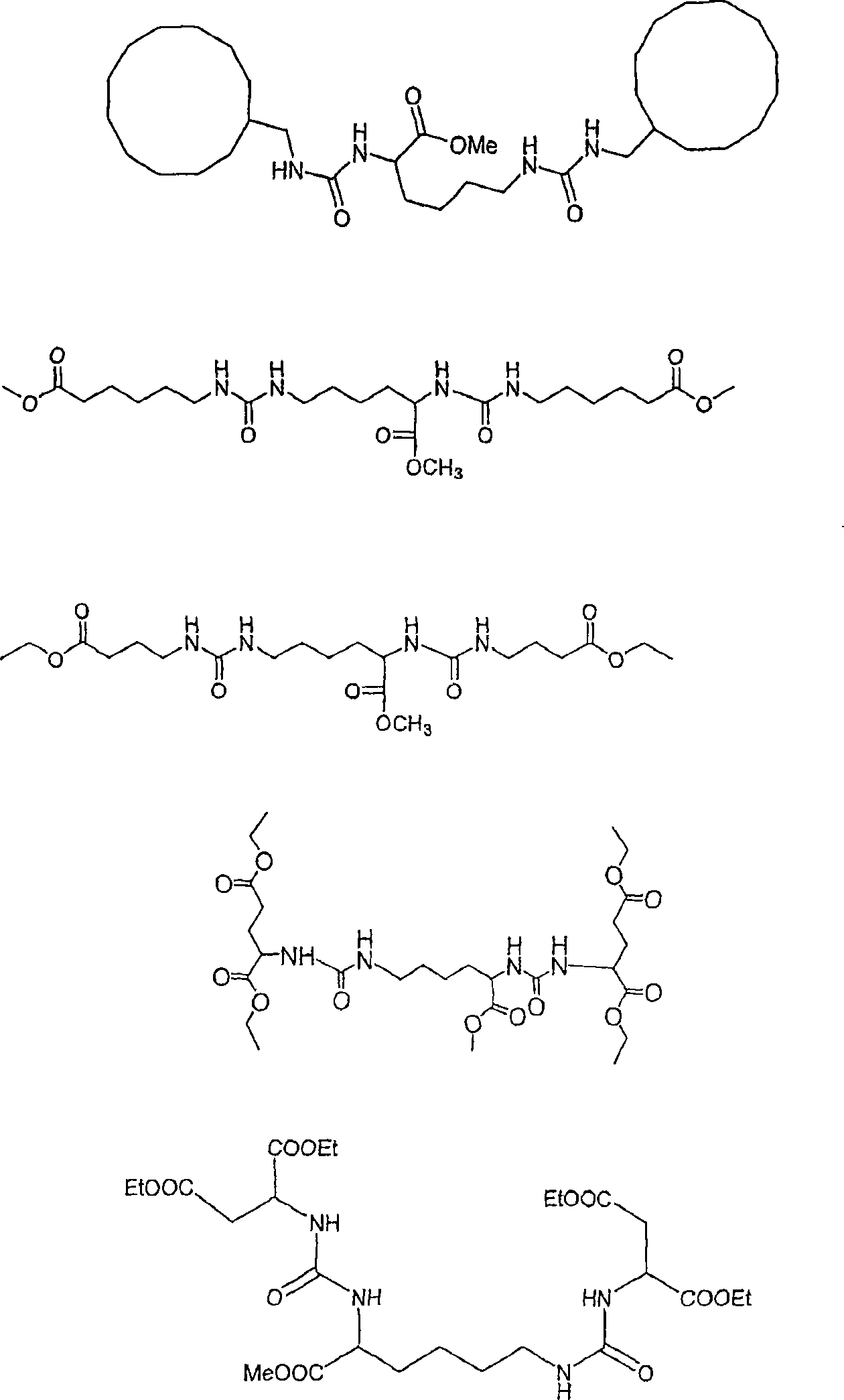Coating compositions containing rheology control agents
A rheology control agent, composition technology, applied in action, dendritic ether, polyether or hydrocarbon chain, can solve the problem of no recommended coating composition, insufficient compatibility, flow of finish paint, etc., to achieve pigment and Improved flake retention, excellent overall appearance, and spray-enhancing effects
- Summary
- Abstract
- Description
- Claims
- Application Information
AI Technical Summary
Problems solved by technology
Method used
Image
Examples
Embodiment 1
[0158] The following reactions were performed under a nitrogen blanket. 2.28 g (0.0107 mol) of methyl lysine diisocyanate as an organic diisocyanate was added dropwise to a flask equipped with a stirrer and filled with a solution of 2.75 g (0.0212 mol) of octylamine in 30 ml of chloroform, The reaction mixture was kept at room temperature under constant stirring for about 2 hours. The reaction mixture was monitored by IR spectroscopy, and when the isocyanate peak (about 2258 cm -1 ) disappeared and the reaction was considered complete and the reaction mixture was filtered to remove the product formed and any residual solvent was removed under vacuum. 4.21 g of product were obtained, a yield of 84%. The resulting rheology control agent has the following formula:
[0159]
Embodiment 2
[0161] The following reactions were performed under nitrogen blanket. 23.18 g (0.1092 mol) of methyl lysine diisocyanate as an organic diisocyanate was added dropwise to a flask equipped with a stirrer and containing 37.05 g (0.2163 mol) of undecylamine in 700 ml of chloroform. solution, the reaction mixture was kept at room temperature under constant stirring for about 2 hours. The reaction mixture was monitored by IR spectroscopy, and when the isocyanate peak (about 2258 cm -1 ) disappeared and the reaction was considered complete and the reaction mixture was filtered to remove the product formed and any residual solvent was removed under vacuum. 53.89 g of product were obtained, a yield of 89.8%. The resulting rheology control agent has the following formula:
[0162]
Embodiment 3
[0164] The following reactions were performed under nitrogen blanket. 14.53 g (0.068 mol) of methyl lysine diisocyanate as an organic diisocyanate was added dropwise to a flask equipped with a stirrer and filled with 25 g (0.1334 mol) of N-cyclohexyl-(2-hydroxyethyl ) urea and 0.08 g of dibutyltin dilaurate in 340 ml of acetonitrile, and the reaction mixture was refluxed at 78° C. for about 2 hours with constant stirring. The reaction mixture was monitored by IR spectroscopy, and when the isocyanate peak (about 2258 cm -1 ) disappeared and the reaction was considered complete and the reaction mixture was filtered to remove the product formed and any residual solvent was removed under vacuum. 36.79 g of product were obtained, a yield of 94.3%. The resulting rheology
[0165] The formulation has the following formula:
[0166]
PUM
| Property | Measurement | Unit |
|---|---|---|
| thickness | aaaaa | aaaaa |
| glass transition temperature | aaaaa | aaaaa |
| thickness | aaaaa | aaaaa |
Abstract
Description
Claims
Application Information
 Login to View More
Login to View More - R&D
- Intellectual Property
- Life Sciences
- Materials
- Tech Scout
- Unparalleled Data Quality
- Higher Quality Content
- 60% Fewer Hallucinations
Browse by: Latest US Patents, China's latest patents, Technical Efficacy Thesaurus, Application Domain, Technology Topic, Popular Technical Reports.
© 2025 PatSnap. All rights reserved.Legal|Privacy policy|Modern Slavery Act Transparency Statement|Sitemap|About US| Contact US: help@patsnap.com



